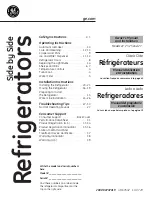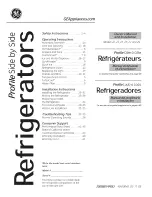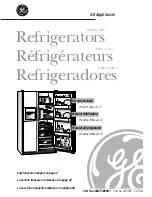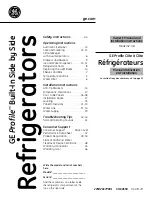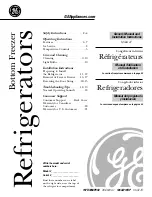
72
Installation Manual
On the Power Flows Page, the icon will flash when there is a
warning. Listed below are the warning codes and their solutions.
Operation and Display Panel
25
RCMU test fault
None
1. Turn the inverter off and then back on using the main switch.
2. If the error remains, contact your installer.
26
Model setting fault
None
1. Turn the inverter off and then back on using the main switch.
2. If the error remains, contact your installer.
27
Battery Voltage Drop
None
1. Battery voltage drop below 30V.
2. Check the battery BMS errors and the wiring.
3. Turn the inverter off and then back on using the main switch.
4. If the error remains, contact your installer.
On the Power Flows Page, the
icon will flash when there is a warning. Below are the warning codes and their solutions.
C
ODE
W
ARNING
ICON
S
OLUTION
53
Stacking Canbus communication error
1. Turn the inverter off using the main switch and check the canbus communication cables.
2.
Turn the inverter on. If error remains, contact your installer.
54
Power island
1. Turn the inverter off and then back on using the main switch.
2. The inverter will wait for 5 minutes before attempting to connect to the Grid.
3. If the error remains, contact your installer.
55
Grid is disconnected
56
Grid voltage exceeds the upper threshold
57
Grid voltage falls below the lower threshold
58
Grid frequency exceeds the upper threshold
59
Grid frequency falls below the lower threshold
61
Battery voltage is too low
1. The battery voltage is less than 44V (lead-acid) or the SOC is lower than 10% (Lithium).
Battery backup function will be turned off and the system output can only work with the
Grid.
2. Wait for the PV or Grid to charge up the battery. The error code will change to 62 once the
battery voltage is above 44V or the SOC is above 10%.
62
Low battery SOC level
1. The battery voltage is less than 47.1V (lead-acid) or the SOC is less than 40% (Lithium).
2. Wait for the PV or Grid to charge up the battery. The error code will clear and battery
backup function will be enabled once the SOC is above 60%.
63
Battery is not detected
1. Turn the inverter off using the main switch.
2. Check battery connection for any loose wiring.
3. Turn the inverter on. If error message remains, contact your installer.
64
Inverter output OCP
1.
Inverter output current exceeds the upper threshold.
2.
Turn the inverter off and then back on using the main switch.
3.
If error remains, contact your installer.
Alarm – On: 1s, Off: 1s
65
RS485 communication error
1. Turn the inverter off using the main switch and check all communication wires.
2.
Turn the inverter on. If error remains, contact your installer.
66
Output derated
1.
When system temperature is too high, the output power has been derated.
2.
Lower the load or lower the environmental temperature.
Notes:
System output lowered to 80% when the system temperature is higher than 80°C.
System output lowered to 60% when the system temperature is higher than 85°C.
System output restored to 100% when the system temperature is lower than 70°C.
25
RCMU test fault
None
1. Turn the inverter off and then back on using the main switch.
2. If the error remains, contact your installer.
26
Model setting fault
None
1. Turn the inverter off and then back on using the main switch.
2. If the error remains, contact your installer.
27
Battery Voltage Drop
None
1. Battery voltage drop below 30V.
2. Check the battery BMS errors and the wiring.
3. Turn the inverter off and then back on using the main switch.
4. If the error remains, contact your installer.
On the Power Flows Page, the
icon will flash when there is a warning. Below are the warning codes and their solutions.
C
ODE
W
ARNING
ICON
S
OLUTION
53
Stacking Canbus communication error
1. Turn the inverter off using the main switch and check the canbus communication cables.
2.
Turn the inverter on. If error remains, contact your installer.
54
Power island
1. Turn the inverter off and then back on using the main switch.
2. The inverter will wait for 5 minutes before attempting to connect to the Grid.
3. If the error remains, contact your installer.
55
Grid is disconnected
56
Grid voltage exceeds the upper threshold
57
Grid voltage falls below the lower threshold
58
Grid frequency exceeds the upper threshold
59
Grid frequency falls below the lower threshold
61
Battery voltage is too low
1. The battery voltage is less than 44V (lead-acid) or the SOC is lower than 10% (Lithium).
Battery backup function will be turned off and the system output can only work with the
Grid.
2. Wait for the PV or Grid to charge up the battery. The error code will change to 62 once the
battery voltage is above 44V or the SOC is above 10%.
62
Low battery SOC level
1. The battery voltage is less than 47.1V (lead-acid) or the SOC is less than 40% (Lithium).
2. Wait for the PV or Grid to charge up the battery. The error code will clear and battery
backup function will be enabled once the SOC is above 60%.
63
Battery is not detected
1. Turn the inverter off using the main switch.
2. Check battery connection for any loose wiring.
3. Turn the inverter on. If error message remains, contact your installer.
64
Inverter output OCP
1.
Inverter output current exceeds the upper threshold.
2.
Turn the inverter off and then back on using the main switch.
3.
If error remains, contact your installer.
Alarm – On: 1s, Off: 1s
65
RS485 communication error
1. Turn the inverter off using the main switch and check all communication wires.
2.
Turn the inverter on. If error remains, contact your installer.
66
Output derated
1.
When system temperature is too high, the output power has been derated.
2.
Lower the load or lower the environmental temperature.
Notes:
System output lowered to 80% when the system temperature is higher than 80°C.
System output lowered to 60% when the system temperature is higher than 85°C.
System output restored to 100% when the system temperature is lower than 70°C.
Error and Warning Definition
20190617
On the Power Flows Page, the
icon will flash when there is an error. Below are the error codes and their solutions.
C
ODE
F
AULT
E
VENT
A
LARM
ICON
S
OLUTION
01
DC bus voltage exceeds the upper
threshold
None
1. Turn off the inverter using the main switch.
2. Make sure PV voltage is below 500Vdc.
3. When the Grid is absent, disconnect any grid-tied inverter from to the load
terminal.
4. Turn the inverter on. If the error remains, contact your installer.
02
Arc occurs on PV
None
1. Turn the inverter off and then back on using the main switch.
2. If the error remains, contact your installer.
03
DC bus voltage falls below the lower
threshold
None
1. Turn off the inverter using the main switch.
2. Measure the voltage at the battery and at the cabling above and below the
battery disconnect to make sure voltage is within 44 to 58Vdc.
3. If the voltages are in range, check if the battery went into protection mode.
4. Turn the inverter on. If the error remains, contact your installer.
04
Parallel setting is not correct
None
1. Check the parallel setting and mode setting.
2. Check the communication cable between stacking system.
3. Turn the inverter off and then back on using the main switch.
4. If the error remains, contact your installer.
05
Battery discharging current exceeds
the upper threshold
On: 1s
Off: 1s
1. Turn off the inverter using the main switch.
2. Make sure the Grid and Load terminals are wired properly.
3. Turn the inverter on. If the error remains, contact your installer.
06
Battery charging current exceeds the
upper threshold
On: 1s
Off: 1s
07
Short circuit on PV1 input
None
1. Turn the inverter off and then back on using the main switch.
2. If the error remains, have your installer check the PV array for short circuits.
08
Short circuit on PV2 input
None
09
Short circuit on AC
output
Continuous
5. Turn off the inverter using the main switch.
6. Turn off the load breaker.
7. Make sure L1, L2 and N on the load circuit are not shorted.
8. Turn the inverter on. If the error remains, contact your installer.
10
Leakage current CT fault
None
1. Turn off the inverter using the main switch.
2. Turn the load breaker off.
3. On the essential loads, check all appliances are not leaking current. If so, unplug
the appliance safely.
4. Turn the inverter on. If the error remains, turn the Grid and PV breakers off.
●
On the PV side, measure and make sure the impedance of PV1+, PV1-, PV2+
and PV2- to ground and to each other should be an open circuit.
●
On the Grid side, measure and make sure the impedance of L1, L2 and N
relative to ground and to each other should be an open circuit.
5. Turn the inverter off, then back on. If the error remains, contact your installer.
11
DC/DC Current Sensor fault
None
1. Turn the inverter off and then back on using the main switch.
2. If the error remains, contact your installer.
13
PV Current Sensor fault
None
14
EEPROM read failure
None
15
Communication with main & secondary
controllers are interrupted
None
16
Over temperature fault
On: 1s
Off: 1s
1. The internal temperature is too high.
2. Make sure the inverter is properly ventilated by removing any obstruction around
the vents.
3. Make sure the fans are working.
4. Turn off the inverter using the main switch and let it cool down for 10 minutes
before turning it back on.
5. If the error remains, contact your installer.
17
PV input voltage exceeds the upper
threshold
None
1. If the PV V
OC
is higher than 500VDC, contact your installer.
2. If the PV V
OC
is less than 500VDC, turn off the inverter and restart it after 5
seconds. If the error remains, contact your installer.
18
Over power protection
On: 0.25s
Off: 0.75s
1. The Grid/ Load power has been over 7.5kW for 30s.
2. Turn off the inverter using the main switch.
3. Make sure the load is lower than 5kW
4. Turn the inverter on using the main switch.
5. If the error remains, contact your installer.
19
PV insulation resistance is too low
None
1. Turn off the PV breaker.
2. Check if the impedance between positive and negative poles to the ground is
greater than 1MΩ.
3. If the impedance is lower than 1MΩ, contact your installer.
20
Battery charging voltage is too high
None
1. Turn off the inverter using the main switch.
2. Make sure the connection between battery and inverter has firm and solid
contact.
3. Make sure the battery voltage is within manufacturer’s specifications.
4. Turn the inverter on. If the error remains, contact your installer.
21
Fan fault
None
1. Turn the inverter off and then back on using the main switch.
2. Make sure the fans are working. If the error remains, contact your installer.
C
ODE
F
AULT
E
VENT
A
LARM
ICON
S
OLUTION
22
Overload
On: 0.25s
Off: 0.75s
1. The load exceeds available output power. This error will disappear once load is in
a acceptable range.
2. If the overload occurs for more than 40 seconds, the inverter will automatically
restart. The inverter only allows 3 overload restarts within 5-minute intervals.
3. If the inverter is constantly restarting due to overload, you should decrease your
load.
23
PV input over power
None
1. Make sure your PV arrays does not exceed 6.5kW.
2. Turn the inverter off and then back on using the main switch.
3. If the error remains, contact your installer.
24
Battery type is wrong
None
1. Set the correct battery type according to the battery installed to the system.
2. Turn the inverter off and then back on using the main switch.
3. If the error remains, contact your installer.
Содержание EverVolt EVAC-105-6
Страница 1: ...V 01012021 Installation Service Manual FOR AC AND DC COUPLED EVERVOLT SYSTEMS ...
Страница 65: ...65 Installation Manual Operation and Display Panel ...
Страница 76: ...76 Installation Manual Configuring the Hardware PV INPUT IS ONLY USED FOR EVERVOLT DC COUPLED SYSTEM ...
Страница 83: ...83 Installation Manual Step 5 Install the Generator wire ...































